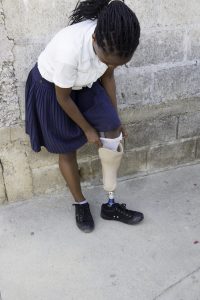Sepsis and Amputations: April is Limb Loss Awareness Month
April 6, 2018
People of all ages and from all walks of life lose limbs for a variety of reasons, and the number is growing. In 2005, there were 1.6 million people in the United States with amputations, one person out of every 190. Researchers say that if the causes are not addressed, this number could double by the year 2050. The Amputee Coalition says that 60% of amputations are preventable. April is Limb Loss Awareness Month, a time to draw attention to the many people affected by limb loss and the reasons why amputations are performed.

Limb loss has many causes, the most common being the result of vascular diseases such as atherosclerosis combined with diabetes. However, over 10% of amputations in the U.S. are performed on patients who have had sepsis. In 2012, there were about 13,700 amputation procedures performed in the U.S. on patients with a related diagnosis of sepsis. This works out to an average of 38 per day. If sepsis is prevented or treated early enough so it doesn’t progress to severe sepsis or septic shock, this number could decrease dramatically.
Sepsis can do a lot of harm to your body. It can cause your blood to form small clots in blood vessels, which can block blood from reaching your limbs. Without adequate blood flow, tissues become starved of oxygen and nutrients, and they die. When too much of the tissue dies (becomes gangrenous), it has to be removed. If only a small area of tissue has died, surgeons can limit the amount that has to be removed. But sometimes more drastic measures must be taken and parts of the body must be amputated.
As part of the Faces of Sepsis campaign, Sepsis Alliance has so far collected nearly 800 stories of people who have survived sepsis or who have died from sepsis. Many are from people who underwent amputations because of sepsis.
 Kamil was only 10 months old when he became ill with sepsis. His doctors had to amputate both feet and one hand. April was 42 when she became ill and lost all the toes on one foot. Jen Ludwin, who is featured in the Sepsis Alliance video, Sepsis: Emergency, was a college student when she contracted the flu (influenza), which triggered sepsis. After she recovered, doctor had to amputate both legs and several fingers.
Kamil was only 10 months old when he became ill with sepsis. His doctors had to amputate both feet and one hand. April was 42 when she became ill and lost all the toes on one foot. Jen Ludwin, who is featured in the Sepsis Alliance video, Sepsis: Emergency, was a college student when she contracted the flu (influenza), which triggered sepsis. After she recovered, doctor had to amputate both legs and several fingers.
Sepsis can’t always be prevented but by caring for yourself when you do become ill or develop an infection and treating infections seriously, you can decrease the risk of sepsis. By being aware of your body and the signs and symptoms of sepsis, you can help recognize it and seek early treatment, when it is most effective, reducing the chances of the disease progressing and causing permanent damage to your body.
Click here to read more stories about sepsis and amputations. If you would like to share your story, please click on Send Us Your Story at FacesOfSepsis.org.
Life After Sepsis: Amputations





























